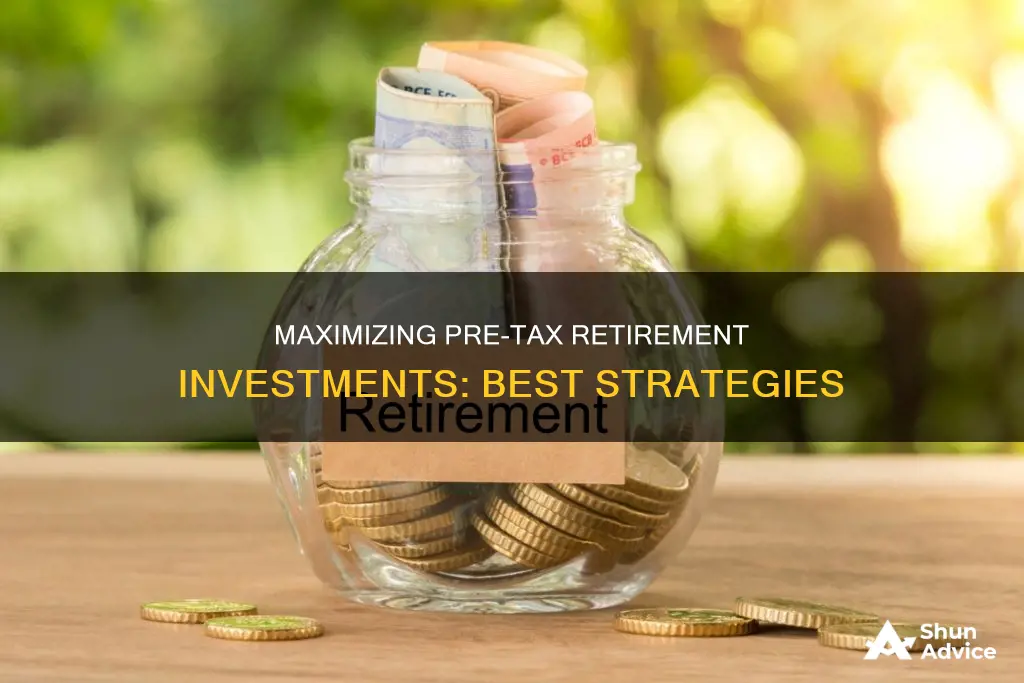
Investing in a retirement fund is a crucial step towards financial security. While it can be daunting to start saving for retirement, it is essential to begin as early as possible to maximise the benefits. The first step is to understand the different types of retirement plans available, such as 401(k) plans, IRAs, and annuities. These plans offer various tax advantages, and it is important to choose the right investments and accounts to hold those investments. Tax-efficient investing is a good strategy, especially for those in higher tax brackets, as it helps to minimise taxes and maximise returns. It is also important to consider the level of risk when choosing investments and to diversify your portfolio to minimise risk. Seeking advice from a financial advisor or tax specialist can be beneficial in making informed decisions about retirement planning.
| Characteristics | Values |
|---|---|
| Type of Account | Taxable Accounts (e.g. Brokerage Accounts) and Tax-Advantaged Accounts (e.g. IRAs and 401(k)s) |
| Tax Treatment | Taxed according to how long the asset was held and sold |
| Investment Options | Individual Stocks, Tax-Managed Stock Funds, Index Funds, Exchange-Traded Funds (ETFs), Low-Turnover Stock Funds, Treasury Bonds, Series I Bonds, Municipal Bond Funds, Real Estate Investment Trusts (REITs) |
| Annual Contribution Limits | Tax-advantaged accounts like IRAs and 401(k)s have annual contribution limits. In 2024, individuals can contribute $7,000 to IRAs, or $8,000 if they're age 50 or older. Investors can contribute to their 401(k)s up to $23,000 or $30,500 with the catch-up contribution. |
| Flexibility | Taxable accounts offer more flexibility than tax-advantaged accounts. |
| Restrictions | Tax-advantaged accounts have restrictions and penalties if individuals are below retirement age when they withdraw. |
| Investment Returns | After-tax returns matter more than pre-tax returns. |
| Investment Selection | Investment selection and asset allocation impact investment returns. |
What You'll Learn

Tax-advantaged accounts
Tax-Deferred Accounts
Traditional IRAs and 401(k) plans are examples of tax-deferred accounts. With these accounts, you get an upfront tax break as you contribute with pre-tax dollars. Taxes are only paid when you withdraw the money during retirement. This means that the tax is deferred until a later date. The downside is that withdrawals before the retirement age are typically subject to penalties.
Tax-Exempt Accounts
Roth IRAs and Roth 401(k)s are examples of tax-exempt accounts. Contributions to these accounts are made with after-tax dollars, meaning you've already paid taxes on this money. The benefit of these accounts is that investments grow tax-free, and qualified withdrawals during retirement are also tax-free. This means you won't have to pay any further taxes on this money.
Annual Contribution Limits
It's important to note that tax-advantaged accounts like IRAs and 401(k)s have annual contribution limits. In 2024, individuals can contribute up to $7,000 to IRAs, with a catch-up contribution of $1,000 for those aged 50 or older. For 401(k)s, the contribution limit is $23,000, or $30,500 with the catch-up contribution. These limits should be considered when planning your retirement savings strategy.
Choosing the Right Account
When deciding between taxable and tax-advantaged accounts, it's important to consider the type of investments you plan to hold. Taxable accounts, such as brokerage accounts, offer more flexibility and fewer restrictions. Tax-advantaged accounts, on the other hand, provide tax benefits but come with annual contribution limits and penalties for early withdrawals.
To maximize tax efficiency, it's recommended to place investments with higher tax efficiency in taxable accounts and those with lower tax efficiency in tax-advantaged accounts. Consult a financial advisor or tax specialist to determine the best strategy for your specific situation.
Invest in Precious Metals Mutual Funds: A Beginner's Guide
You may want to see also

Taxable accounts
While tax-advantaged retirement accounts like 401(k)s and IRAs are popular investment vehicles, taxable accounts also have their advantages. Here are some reasons why you may want to consider investing in taxable accounts before contributing to tax-advantaged retirement funds:
- Accessibility and Flexibility:
- No Contribution Limits:
Tax-advantaged accounts like 401(k)s and IRAs have annual contribution limits. For example, in 2024, the contribution limit for a 401(k) is $23,000 ($30,500 if you're 50 or older). On the other hand, taxable accounts do not have such restrictions, allowing you to save and invest more aggressively if you have the means to do so.
Tax Efficiency with Certain Investments:
While taxable accounts don't offer the upfront tax benefits of tax-advantaged accounts, you can still minimize taxes by carefully selecting your investments and employing tax-efficient strategies. Here are some tax-efficient investments typically suited for taxable accounts:
- Municipal Bonds: Municipal bonds issued by state, local, and county governments are exempt from federal taxes. If you buy bonds from your state of residence, they may also be exempt from state and local taxes. This makes them very tax-efficient, especially for investors in higher income tax brackets.
- Series I Bonds and Treasury Bonds: These bonds are exempt from state and local income taxes, although they are subject to federal taxes.
- Exchange-Traded Funds (ETFs): ETFs are tax-efficient because they track a market index and don't trade frequently, resulting in fewer taxable events and lower capital gains distributions. Equity ETFs, in particular, can be a good choice for taxable accounts.
- Passive Funds and Index Funds: Passive funds, like index funds, tend to be more tax-advantaged than actively managed funds because they don't trade frequently. This results in fewer taxable events, and you can hold them for the long term to benefit from lower long-term capital gains tax rates.
- Qualified Dividend-Paying Stocks: Qualified dividends are taxed at the lower capital gains tax rate, whereas ordinary dividends are taxed at the higher ordinary income tax rate.
Supplementing Retirement Savings:
If you don't have access to a 401(k) through your employer or have maxed out your contributions to tax-advantaged accounts, taxable accounts can help you save more for retirement. This is especially useful if you're aiming to save 15% or more of your household gross income for retirement, as recommended by financial planners.
Tax Diversification:
Using a combination of pretax, Roth, and taxable accounts for retirement savings provides tax diversification. This strategy can be beneficial if you're unsure what tax bracket you'll be in during retirement. It allows you to develop a sustainable withdrawal strategy, ensuring your savings last as long as possible.
Remember that when investing in taxable accounts, it's essential to be mindful of fees and how interest, dividends, and capital gains are taxed. Consult a financial advisor or tax specialist to determine the best investment strategy for your specific situation.
Lending Club: Funds Investing in Peer-to-Peer Loans
You may want to see also

Tax-efficient investing strategies
Taxes can be one of the biggest expenses on investments, so it's important to consider tax-efficient investing strategies when saving for retirement. Here are some ways to maximize tax efficiency and minimize your tax burden:
- Choose the right type of account: There are two main types of investment accounts: taxable and tax-advantaged. Taxable accounts, such as brokerage accounts, offer more flexibility but have fewer tax benefits. Tax-advantaged accounts, such as IRAs and 401(k)s, provide tax breaks but have annual contribution limits.
- Select the right investments for each account type: Tax-efficient investments, such as tax-managed funds, exchange-traded funds (ETFs), and municipal bonds, are better suited for taxable accounts. Less tax-efficient investments, such as corporate bonds and actively managed funds, are better suited for tax-advantaged accounts.
- Consider a Roth option for your retirement account: Roth IRAs and Roth 401(k)s are tax-exempt accounts, which means you contribute with after-tax dollars, but your investments grow tax-free, and qualified withdrawals in retirement are tax-free.
- Maximize contributions to tax-advantaged accounts: Take advantage of the tax benefits offered by IRAs and 401(k)s by contributing the maximum amount allowed each year. In 2024, individuals can contribute up to $7,000 to IRAs ($8,000 if age 50 or older) and up to $23,000 to 401(k)s ($30,500 with a catch-up contribution).
- Utilize a health savings account (HSA): If you have a high-deductible health plan, consider opening an HSA. This allows you to set aside money on a pre-tax basis for qualified medical expenses. Any money not used can remain in the account for future tax-free medical withdrawals. After age 65, you can take penalty-free distributions for any reason.
- Practice asset location: Divide your assets among taxable and tax-deferred accounts. Place tax-efficient investments in taxable accounts and investments with a heavier tax burden in tax-advantaged accounts.
- Offset capital gains with losses: You are taxed on net capital gains, so any realized losses can help lower your tax bill. This strategy is known as tax-loss harvesting.
- Be tax-efficient with withdrawals: When taking money out of your portfolio, consider moving any income produced from your investments (dividends, interest, and capital gains) to a money market account instead of reinvesting it. This way, you avoid paying taxes twice.
- Maximize charitable giving: If philanthropy is part of your investment goals, consider donating appreciated securities, such as mutual funds, ETFs, or individual stocks, to minimize future capital gains. You can also itemize cash donations on your tax return to take advantage of tax deductions.
Remember, it's important to consult a qualified investment planner, financial advisor, or tax specialist to determine the best tax strategy for your individual situation.
Invest Wisely: Understanding Sensex Funds for Beginners
You may want to see also

Retirement account options
There are several types of retirement accounts to choose from, each with its own advantages and considerations. Here are some of the most common options:
- Employer-sponsored plans: These include 401(k), 403(b), and 457(b) plans, as well as pension plans. The 401(k) is the most common type of employer-sponsored retirement plan, allowing employees to contribute pre-tax dollars and often offering employer matching contributions. The 403(b) plan is similar but is offered by public schools, charities, and certain tax-exempt organizations. The 457(b) plan is available to state and local government employees. Pension plans, also known as defined-benefit plans, are fully funded by employers and provide a fixed monthly benefit but are becoming less common.
- Individual Retirement Accounts (IRAs): IRAs come in two main types: traditional and Roth. Traditional IRAs allow you to contribute pre-tax dollars, lowering your taxable income, while Roth IRAs use after-tax dollars, allowing tax-free withdrawals in retirement. Both types have annual contribution limits, and Roth IRAs are subject to income limits.
- Self-employed or small business plans: These include the SEP IRA, SIMPLE IRA, solo 401(k), and profit-sharing plans. The SEP IRA allows employers of any size, including the self-employed, to contribute pre-tax dollars toward employees' retirement. The SIMPLE IRA offers a 3% employer match or a 2% non-elective contribution. The solo 401(k) is designed for business owners and their spouses, allowing elective deferrals of up to $23,000 in 2024, plus additional contributions.
When choosing a retirement account, it's important to consider factors such as tax advantages, contribution limits, employer matching, investment options, and portability. It's also crucial to start saving as early as possible and to maximize any employer-matching contributions.
Oppenheimer Funds: Puerto Rico Debt Investment Status
You may want to see also

Investment options for generating income
There are several investment options to help you generate income for your retirement. Here are some of the most common ones, listed from lower to higher risk:
- Income annuity: This is a contract between you and an insurance company where you pay a sum of money, either as a lump sum or monthly, in exchange for regular income payments. Annuities can provide a steady, predictable source of income in retirement, regardless of market fluctuations, and offer tax-deferred growth and tax-advantaged income. However, guarantees are subject to the claims-paying abilities of the insurance company, and there may be limited liquidity.
- Diversified bond portfolio: Fixed-income instruments such as bonds offer a steady stream of income with potentially competitive yields and provide liquidity and access to a wide range of fixed-income instruments. However, bond income is taxed at ordinary income rates, and there is a risk of principal loss if interest rates move higher.
- Total return investment approach: This approach provides income from your investment portfolio in the form of interest, dividends, and capital gains. It involves investing in a balanced and diverse mix of stock and bond funds, with the aim of generating a superior total return compared to other retirement income strategies. While this approach can meet your immediate cash flow needs and provide a broader range of assets, there is no guarantee that funds will last throughout retirement, and the value of your returns may vary from year to year.
- Income-producing equities: While stocks are typically chosen for capital appreciation, some equities provide income in the form of dividends. Companies usually pay dividends on a quarterly basis, and dividend-paying stocks can offer a regular stream of income and the opportunity to benefit from capital appreciation. However, not all companies are reliable in their dividend payouts, and dividend income may be subject to higher tax rates.
Other investment options for generating retirement income include:
- Robo-advisors or target-date funds: These are automated investment services that provide a hands-off approach to managing your investments. They charge additional fees but offer the benefit of automatic rebalancing of your portfolio as you age and markets change.
- Dividend-paying stocks: These stocks provide consistent, steady income in the form of monthly, quarterly, or annual dividend payments. While they may not offer the same exponential growth as newer, smaller companies, they can be a good option for investors seeking regular income.
- Rental properties or real estate investment trusts (REITs): Investing in rental properties can provide regular cash flow, but it also comes with expenses such as maintenance and repairs. REITs offer a way to invest in real estate with less hassle and provide diversification for your portfolio.
- Health savings accounts (HSAs): HSAs are designed for covering medical expenses but can also be used as a supplemental retirement account. They offer tax advantages, and after age 65, you can use the funds just like a traditional IRA without penalties.
- Social Security and part-time work: Social Security can replace about 40% of pre-retirement earnings for lower wage earners and 33% for higher earners. Supplementing this with part-time work during retirement can provide additional income and the mental benefits of staying active.
SP 500 ETF vs Index Funds: Where Should You Invest?
You may want to see also
Frequently asked questions
Tax-advantaged retirement accounts, such as 401(k)s and IRAs, offer tax-deferred or tax-free growth on your investments. This means that you won't have to pay taxes on the gains until you withdraw the funds during retirement, or possibly not at all if you choose a Roth account.
With a traditional IRA, you contribute pre-tax dollars, meaning your contributions are not considered taxable income. You will, however, have to pay taxes on the gains when you withdraw the funds during retirement. On the other hand, a Roth IRA is funded with after-tax money, so you won't have to pay any taxes on withdrawals in retirement.
There are several investment options available to help generate income during retirement, including income annuities, bond portfolios, total return investment approaches, and income-producing equities. Each option has its own risks and rewards, so it's important to consider your financial goals and risk tolerance when making a decision.
When selecting investments for your retirement portfolio, it's crucial to consider your goals, risk tolerance, and time horizon. Diversification is key to reducing overall investment risk while increasing the potential for returns. Mutual funds, index funds, and ETFs are great options for diversifying your portfolio without having to purchase and manage individual securities.
A target-date fund is an investment fund that automatically adjusts its asset allocation over time based on a predetermined timeline. You select the target date, usually your expected retirement year, and the fund company handles the rest. This is a hands-off approach to investing for retirement that can be a good option for those who don't want to actively manage their portfolio.







